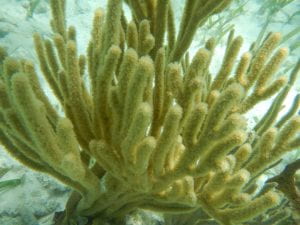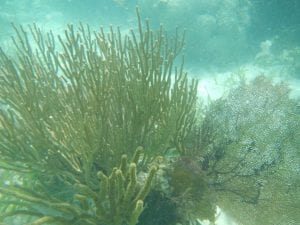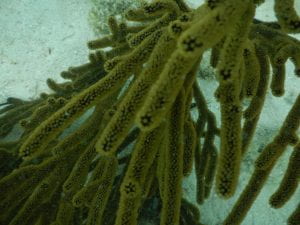Today we took a small boat out to a reef outside the Marine Protected Area to start surveying our first large research question! We wanted to find out how live coral cover correlates with sea urchin prevalence. We went out to a shallow patch reef, and the strong waves today made it very difficult to do any surveying! I kept being accidentally washed into corals! We did get to see many sea urchins, including the Diadema antillarum, which has seen drastic population declines since the 1970s. The specimen we picked up in the field is shown in the picture below:
After our data collection, we visited another patch reef within the Marine Protected Area. Here I found lots of common sea fans, a soft coral, that were partially dead and diseased. I learned in a lecture today that many of them likely had the disease aspergillosis. I also saw many other soft corals that were harder to identify. Many of them have a candelabrum or bushy shape with branches coming up, and brown or tan polyps.
Here are a few I saw on the reefs today:
I think this one might be a Black Sea rod (Plexaura homomalla), as it has dark stalks with contrasting light polyps:
The most exciting part of today was when one of our guides, Claudius, found a giant adult Lionfish! It was around 10 inches long and very showy. Since Lion Fish are invasive to this area, and very damaging, our professors worked together to spear and capture it. Later at the station they humanely killed it, and have talked about turning it into ceviche for us to eat! Even though I am vegetarian, I think I will make an exception to help clear up the invasive Lionfish population here in Belize!
(Here is a poorly transferred picture of Scott with the lionfish speared and ready to put into the bag Adrienne is holding!)
– Ava





